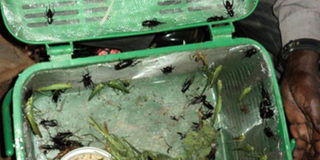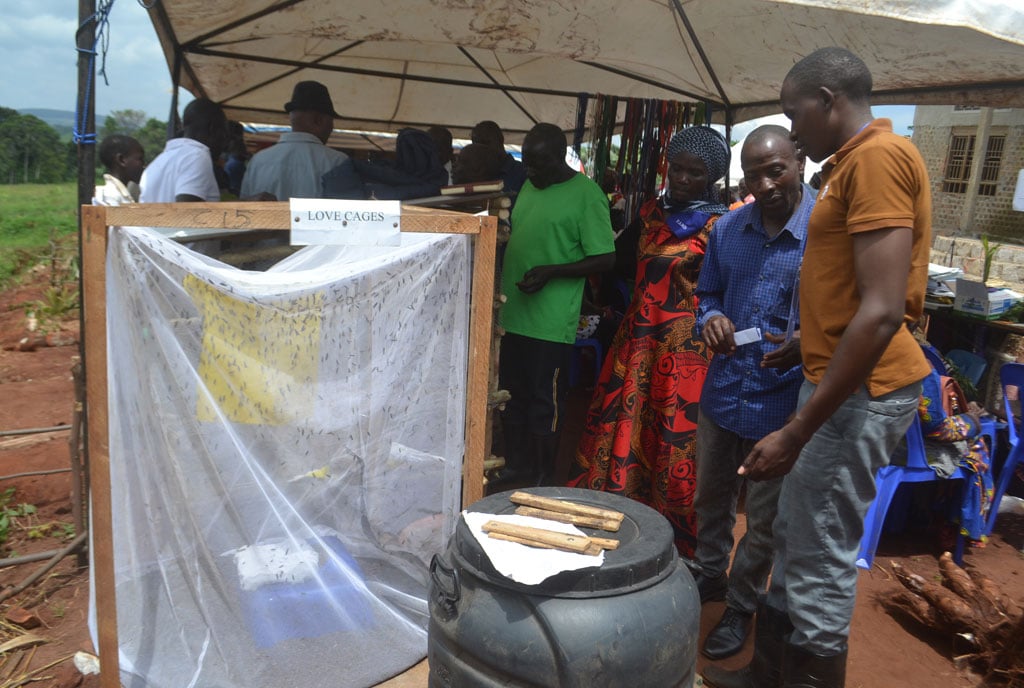Prime
What it takes to rear insects for use as animal feeds

Insects such as grasshoppers and crickets are rich source for nutrients to supplement diet and present an opportunity for business.d. Photo | File
What you need to know:
- Crickets have 62.3 to 67 percent protein, which is equivalent to the percentage in fish, whose protein levels are about 66 percent and ahead of chicken, which has 30 percent
High price of feeds remains the biggest burden to many livestock farmers, with the input accounting for up to 60 percent of the total production costs.
Farmers can, however, bring down the costs by rearing insects such as crickets and black soldier flies on the farm to use as feeds.
Dr Sevgan Subramanian, a principal scientist at the International Centre of Insect Physiology and Ecology (Icipe), notes that crickets, black soldier flies and locusts can be used to make nutritious feeds for fish, poultry and pigs.
Nutritious feeds
For crickets, scientists have identified the species Scapsipedus icipe, which is edible and can also be mass-produced for human consumption as a quality protein ingredient in animal feeds.
The insect is commonly found around buildings and in fields and bears a yellow band between the eyes, differentiating it from other species.
Crickets have 62.3 to 67 percent protein, which is equivalent to the percentage in fish, whose protein levels are about 66 percent and ahead of chicken, which has 30 percent. The expert notes that 10 crickets collected from behind the yard or on the farm can make a colony in few months.
Starting
To start raring them, one needs a plastic box with a lid (the size of a ballot box), used grains commonly known as machicha, cotton balls and egg trays made of paper.
The egg trays are arranged inside the plastic box and moist cotton balls, whose sizes are smaller than a fist, are placed in random places inside. Once the houses are ready, a farmer then captures the insects and keeps them in the box in a warm room.
Completely dried then ground
The crickets feed on the used grains inside the box and more should be added when they are depleted. According to the scientist, insufficient feeds may see the crickets to cannibalise each other to meet their protein demand.
The used (spent) grains, which can be from sorghum, are high in protein and carbohydrates. It is also recommended that high quality feeds and a balanced diet be given to the insects, especially if they are being kept for human consumption. “As the natural mating process starts, the female crickets will lay eggs inside the cotton balls, which provide a conducive ground to save them from drying up. This ensures 90 percent hatchability,” Dr Subramanian explains.
Moist cotton balls also help provide drinking water for the insects, including the males, which are known to eat eggs. The females, therefore, learn to push their eggs inside the cotton balls for safety. After five days, fresh cotton balls should be put into the boxes and the old ones with eggs transferred to another container and left to hatch.
“The advantage with crickets is that generations can be created by just providing them with food and water. Crickets can breed quickly, often multiplying within 10 days,” says Dr Subramanian, adding that it takes 34 days for the insects to mature.
From a single box with 5,000 eggs, a farmer gets three to four kilogrammes of mature insects during harvesting.
It is estimated that 1,000 insects make a kilogramme. Hence, the more containers a farmer has, the more the kilogrammmes to be fetched.
Laying eggs
Although crickets can survive for up to four months, the egg-laying stage is usually in the first month.
It is therefore not economical to continue feeding them when they are no longer creating another generation, notes the scientist.
The harvested crickets are completely dried and ground into powder using a machine. The powder is then used as a source of protein when making animal feeds. It can also be used to make biscuits or added to baby porridge.
Black soldier fly rearing
To rear black soldier flies, known as Hermetia illucens, one uses a low-cost technology involving a carton box and a pile of kitchen waste or spent grain.
A section of the carton is cut to make crevices, which flies like laying eggs in. It is then placed in a container of waste, say in a sheltered yard or under a tree.
The waste will attract black soldier flies to feed on as natural mating processes occur. The female flies will lay their eggs within five days in the crevices. A farmer then waits for four days; within which the eggs hatch into larvae. The waste provides food that can sustain the larvae (maggots) up to the harvest time, which is between 12 to 21 days.
Dr Chrysantus Mbi Tanga, a leading research scientist at Icipe, says the technology has been tried for three years and found successful.
“After 21 days, the content is sieved. The waste goes down, leaving the larvae atop the mesh. The harvesting should be done before they begin to blacken in transition to the pupae stage. Protein levels are lower once they blacken because they would have used some to develop a harder skin,” says Dr Tanga. The choice of the fly is informed by the fact that it has more generations in a year. Each fly lays between 500 and 900 eggs at a go. Cow dung, human waste, rabbit, goat and chicken manure can be used in the place of kitchen waste and spent grains.
After harvest, the maggots are dried under the sun for at least two days before being ground into powder, which is used in making animal feeds.
Dr Tanga says the flour is high in protein and fats and should be mixed with maize germ or whole maize and others to get fully balanced diet feeds for livestock. The final products are either in the form of powder, cake or pellets.




